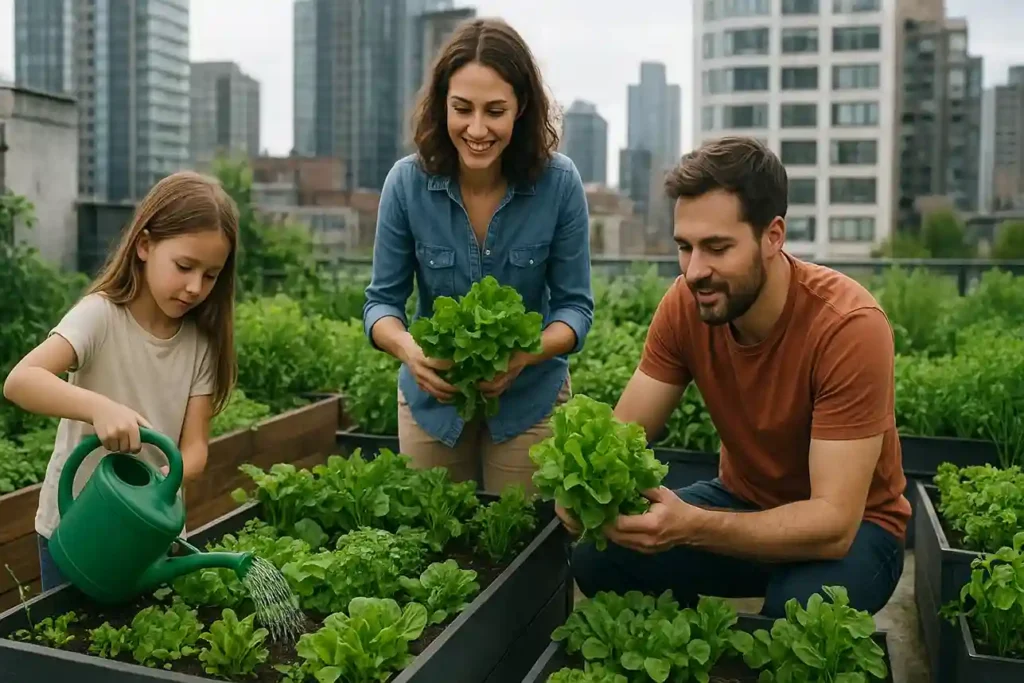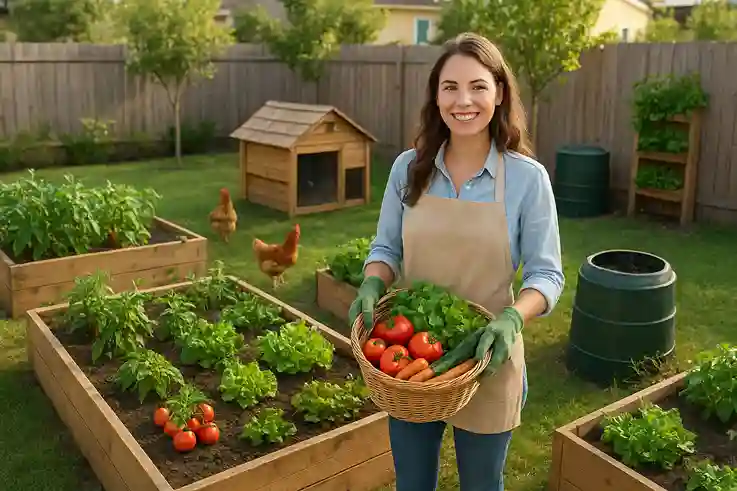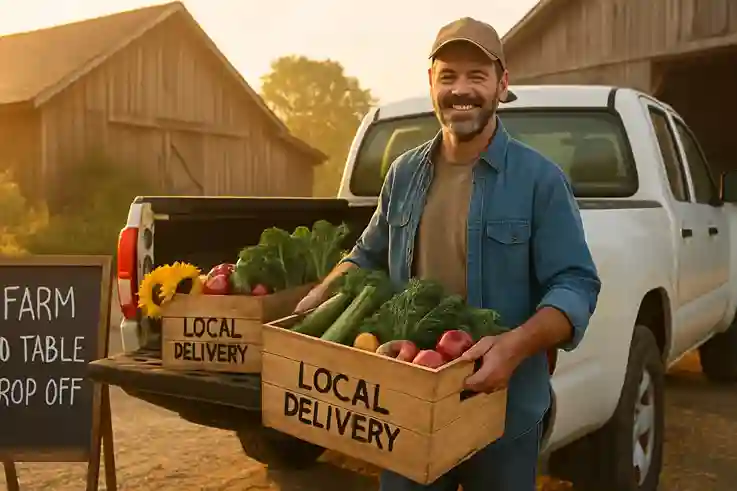What is micro farming? It is a method of growing food on a very small scale, often in backyards, rooftops, or even indoor spaces. Unlike traditional farming that requires acres of land, micro farming focuses on producing fresh, nutritious food using limited space and resources.
This approach is gaining popularity as more people search for sustainable food solutions. With rising food costs, shrinking farmland, and growing environmental concerns, micro farming offers an accessible alternative. It allows individuals and communities to take control of their food supply while reducing reliance on large-scale agriculture.
The benefits are clear. Micro farming uses minimal land, making it ideal for city dwellers. It supports eco-friendly practices by reducing food miles and chemical use. It can also cut grocery bills by supplying fresh produce right at home.
What Is Micro Farming?
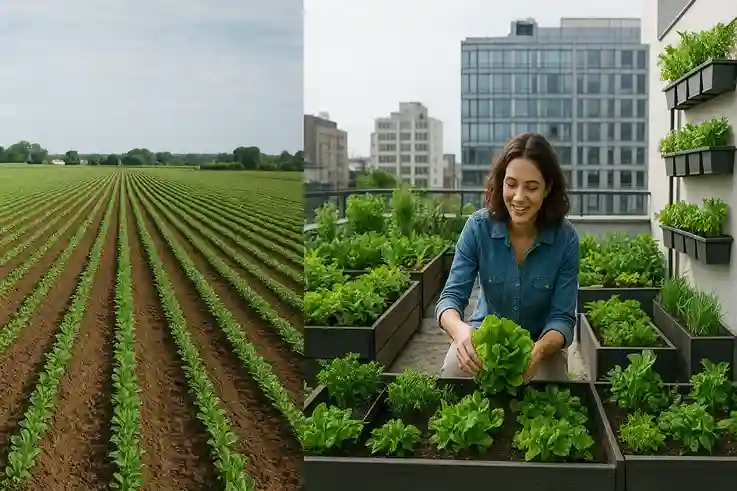
Micro farming is the practice of growing food on a small scale with efficient use of space, water, and resources. It focuses on high productivity from limited areas such as rooftops, balconies, backyards, or small rural plots.
Unlike conventional farming, which often depends on large land areas, heavy machinery, and chemical inputs, micro farming emphasizes sustainable methods. It favors organic soil care, minimal pesticide use, and eco-friendly techniques like composting, hydroponics, or vertical growing systems.
What makes micro farming unique is its flexibility. It works well in crowded urban settings where land is scarce, and it is equally useful in rural areas where farmers want to maximize small plots. This adaptability makes it an accessible solution for anyone looking to grow fresh food in a sustainable way.
The Core Principles of Micro Farming
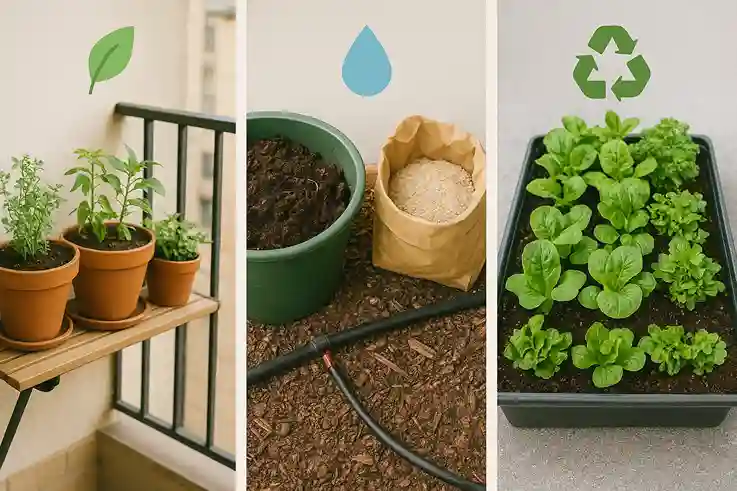
Small Land Use and Intensive Cultivation
Micro farming thrives on limited space, making it ideal for modern lifestyles. Unlike traditional farms that need acres of land, micro farms often work within a few square feet. Backyards, rooftops, balconies, and even small indoor corners can become productive growing areas.
The goal is efficiency. Crops are planted close together to maximize every inch of soil. Many micro farmers also practice succession planting, where one crop follows another in the same spot. This rotation helps keep the soil active and reduces wasted space. Smart planning plays a central role. Raised beds, vertical structures, and container systems allow growers to expand upward when ground space is tight. Companion planting, where different plants grow side by side for mutual benefits, further boosts productivity.
With these methods, a balcony can provide herbs for daily cooking. A small backyard can supply greens for a family. Even a rooftop can produce enough vegetables to cut grocery bills while ensuring freshness. Micro farming proves that small areas can yield big results when managed with care.
Organic and Sustainable Methods
A key principle of micro farming is sustainability. Instead of relying on synthetic chemicals, farmers focus on natural ways to enrich soil and protect plants. Compost made from kitchen scraps, manure, or garden waste becomes a powerful fertilizer. It returns nutrients to the soil and reduces the need for chemical inputs.
Natural fertilizers, like seaweed extracts or vermicompost, help plants grow strong without polluting the environment. Organic soil care also includes mulching, which conserves moisture and keeps weeds under control. These practices improve soil health over time, making it more fertile and resilient. Water management is another focus. Many micro farmers adopt drip irrigation to deliver water directly to plant roots. This prevents waste and reduces evaporation. Some go further by using hydroponics or aquaponics, systems that grow plants without soil while recycling water efficiently.
These eco-friendly techniques benefit both people and the planet. Food grown this way is fresher, cleaner, and safer to eat. At the same time, the reduced chemical footprint supports biodiversity and cuts down on pollution. By choosing sustainable methods, micro farming shows how small-scale agriculture can care for the environment while feeding families.
Focus on High-Yield Crops or Specialty Foods
Micro farming often targets crops that grow quickly and provide frequent harvests. Leafy greens like spinach, kale, and lettuce are favorites because they regrow after cutting. Herbs such as basil, mint, and coriander also thrive in small containers, offering continuous yields with little space. Mushrooms and microgreens are especially popular. Mushrooms grow indoors with minimal light, while microgreens mature in just a few weeks. Both deliver high nutritional value and can even be sold at premium prices in local markets. Their short growth cycles make them perfect for intensive farming.
Modern techniques make micro farming even more versatile. Vertical farming uses stacked layers to grow crops upward, multiplying output without requiring more land. Aqua farming or aquaponics combines fish culture with plant growth, recycling water and nutrients between them. Hydroponics allows plants to grow in nutrient-rich water without soil, while container farming makes use of shipping containers or modular units for controlled environments.
Some growers take a different route by focusing on specialty crops. Exotic herbs, edible flowers, or medicinal plants often attract niche buyers willing to pay more. These crops may require extra care, but they maximize profit from limited land.
By combining smart crop choices with modern techniques, micro farmers ensure steady harvests and better returns. This strategy makes small-scale farming practical, whether the goal is to feed a family or to create income.
Benefits of Micro Farming

Fresh, Local, and Chemical-Free Food
One of the greatest benefits of micro farming is access to fresh produce. Vegetables and herbs can be harvested minutes before cooking, ensuring maximum flavor and nutrition. Since most micro farmers use organic practices, the food is free from harmful chemicals. This means safer meals for families and better health in the long run.
Micro farming also supports the farm-to-table movement. Food goes directly from the garden to the kitchen without long storage or transport. This not only keeps produce fresher but also strengthens the connection between growers and what they eat. Every harvest feels more personal, and every meal becomes a step toward sustainable living.
Reduced Carbon Footprint
Micro farming cuts down on food miles—the distance food travels from farm to plate. Instead of being shipped across countries, crops grow right at home or within communities. This reduces fuel use and greenhouse gas emissions, making every meal more sustainable.
Sustainable methods also play a big role. Composting turns kitchen scraps into natural fertilizer, reducing landfill waste. Drip irrigation and vertical farming save water while increasing productivity. These practices ensure resources are used wisely.
Many micro farms also embrace a zero-waste approach. Plant trimmings, peels, and leftovers return to the soil as compost, closing the nutrient loop. Packaging is often minimal or reusable when selling locally. By designing systems where nothing goes to waste, micro farming creates food that is not only fresh but also responsible.
Income Opportunities for Small-Scale Farmers
Beyond personal use, micro farming also creates strong income potential. Surplus vegetables, herbs, or specialty crops can be sold at local markets, restaurants, or directly to neighbors. This keeps the supply chain short and strengthens community ties.
High-demand items such as microgreens, mushrooms, and medicinal plants often sell at premium prices. Microgreens, for example, are popular with chefs because of their flavor and nutrition, yet they require little space and grow in just two to three weeks. Mushrooms, grown indoors with minimal equipment, can also become a steady source of extra income.
Urban farmers are finding innovative ways to profit from unused spaces. A rooftop can be turned into a herb garden supplying local cafés. A balcony setup can provide organic vegetables for subscription boxes. Even small-scale operations can succeed if they focus on niche crops or direct-to-consumer models.
Micro farming proves that food production does not have to stay limited to large rural farms. With creativity and planning, it can transform into a reliable source of both food and income, even in the heart of a city.
Micro Farming vs. Traditional Farming
Micro farming and traditional farming share the same goal—food production—but they differ greatly in scale and approach. Micro farming is intensive and sustainable, focusing on small plots, organic inputs, and efficient techniques. It produces fresh food for households or nearby markets while keeping the environmental footprint low.
Traditional farming, on the other hand, operates on a much larger scale. It depends on heavy machinery, synthetic fertilizers, and significant land and water resources. While this system supports mass production, it often comes at the cost of soil health, biodiversity, and long-term sustainability.
In simple terms, micro farming works best for communities and families looking for fresh, local food, while traditional farming caters to global demand.
| Aspect | Micro Farming | Traditional Farming |
|---|---|---|
| Scale | Operates on small plots, rooftops, or balconies. Focused on maximizing limited space. | Conducted on large fields, often covering acres of land. Designed for mass production. |
| Input | Relies on organic compost, natural fertilizers, and efficient water use. Labor is more hands-on. | Uses heavy machinery, synthetic fertilizers, pesticides, and large water supplies. |
| Output | Produces fresh food for households or local markets. Often focuses on high-value crops. | Delivers bulk crops for regional, national, or global distribution. |
| Sustainability | Eco-friendly, low carbon footprint, and often zero-waste. Emphasizes soil health and resource conservation. | Resource-intensive, higher emissions, and often linked to soil degradation or biodiversity loss. |
| Flexibility | Can adapt to urban or rural settings. Suitable for beginners and small entrepreneurs. | Fixed to rural farmland, requiring larger investments and infrastructure. |
Technology and Innovation in Micro Farming
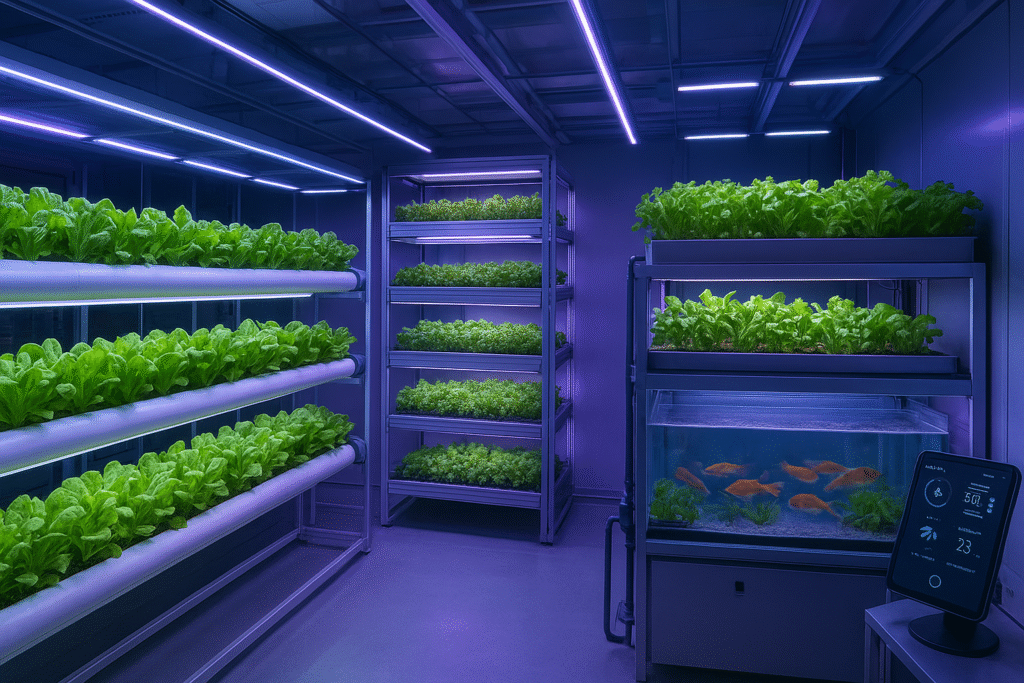
The Hydroponics and Aquaponics Systems
Hydroponics: Soil-Free, Space-Saving Farming
This allows plants to grow without soil, using nutrient-rich water as the growing medium. Instead of spreading roots through the ground, plants sit in containers or channels where water delivers essential minerals directly. This setup ensures that no nutrients are wasted.
One of the biggest advantages is water efficiency. Hydroponic Farming: Everything You Need to Know
systems recycle water, using up to 90% less than conventional farming. This makes them ideal for areas facing drought or limited resources. Another benefit is faster growth. Because nutrients go straight to the roots, plants spend less energy searching for food. Leafy greens, herbs, and strawberries often thrive in hydroponic systems, giving more harvests in less time. For micro farmers, this means higher yields from smaller areas.
Aquaponics: A Balanced Food Ecosystem
Aquaponics goes beyond hydroponics by adding fish farming into the cycle. Fish are raised in tanks, and their waste releases ammonia into the water. Beneficial bacteria then convert this waste into nutrients that plants can absorb. In return, the plants clean the water, which cycles back to the fish tanks.
This closed-loop system reduces waste and creates two food sources at once—fresh vegetables and healthy fish. It requires careful balance, but once established, aquaponics is highly sustainable. For micro farmers, aquaponics offers a way to maximize productivity. Even a small indoor or rooftop setup can produce lettuce, tomatoes, or herbs alongside tilapia or catfish. It demonstrates how farming can mimic natural ecosystems while delivering practical benefits for people.
Vertical Farming Methods
Vertical farming stacks crops in layers, often indoors or on rooftops, making the most of limited land. Instead of spreading plants across fields, crops grow upward in shelves or towers. This design is especially valuable in crowded cities where horizontal space is scarce.
One of the key advantages is protection from harsh weather. Traditional farms face risks from droughts, floods, or extreme heat. Vertical farms, on the other hand, operate in controlled environments. Temperature, humidity, and light are managed to create ideal growing conditions year-round. Artificial lighting, such as LED grow lights, plays a major role. These lights mimic natural sunlight and can be adjusted for different crops. This ensures consistent harvests regardless of outdoor seasons. Leafy greens, herbs, and small fruits often perform well in vertical systems, providing steady yields.
For micro farmers, vertical farming offers scalability. A single rooftop can become a productive farm with stacked layers of crops. Even small operations can produce significant amounts of food while staying sustainable. By growing upward instead of outward, vertical farming proves that space limitations do not have to limit harvests.
Role of Automation and Smart Sensors
Technology now makes micro farming more efficient than ever. Smart sensors can monitor soil moisture, light levels, temperature, and nutrient content in real time. This gives farmers accurate data about what their crops need at any moment. Instead of guessing, they can adjust water, light, or nutrients instantly.
Automated systems build on this precision. Irrigation can be scheduled to deliver just the right amount of water, preventing both waste and plant stress. Temperature and humidity controls keep environments stable, while automated lighting ensures crops get consistent exposure.
These technologies reduce human effort while improving results. A small rooftop farm, for example, can use sensors to track water use and adjust irrigation automatically. This not only saves time but also cuts down on costs and resource consumption. For micro farmers aiming to scale up, automation offers consistency. It reduces the risk of crop failure and makes year-round farming more practical. Combined with hydroponics or vertical systems, smart technology turns micro farms into highly productive, sustainable food hubs.
Together, these innovations transform micro farming from a simple backyard practice into a modern, scalable solution for sustainable food production.
Challenges in Micro Farming
Initial Setup Cost
One of the main hurdles in micro farming is the cost of starting. While it can save money in the long run, the upfront investment often feels steep. Even simple setups require basic tools, containers, and quality soil. More advanced systems like hydroponics, aquaponics, or vertical farming demand pumps, grow lights, and structural support, which can raise costs quickly.
Technology adds another layer of expense. Smart sensors, automated irrigation, and temperature controls improve efficiency but are not always affordable for beginners. Many aspiring micro farmers hesitate to invest without guaranteed returns, especially if they are trying the practice for the first time. However, there are ways to manage costs. Some people start with recycled containers, homemade compost, or small soil beds before expanding. Gradually scaling up allows farmers to spread out expenses over time. Grants, community programs, or local cooperatives may also help offset costs, especially for urban growers.
The key is viewing the setup as a long-term investment. Once established, micro farms often pay for themselves by reducing grocery bills or generating income from surplus produce. While the initial price tag can be a barrier, careful planning makes the transition more achievable.
Knowledge and Time Investment
Micro farming requires more than just planting seeds. Farmers need to learn about soil health, crop rotation, pest control, and modern techniques such as composting or hydroponics. This knowledge takes time to build, and mistakes can reduce yields. Daily care is also important—watering, pruning, and monitoring crops demand consistency. For those balancing jobs or studies, time can be a challenge.
Market Access for Surplus Produce
Selling extra produce is another obstacle for many micro farmers. While growing food for personal use is straightforward, turning it into income requires more effort. Local markets, restaurants, and community buyers often welcome fresh, chemical-free produce, but reaching them takes planning and persistence.
Packaging is the first step. Crops must be cleaned, sorted, and stored properly to maintain quality. Attractive and eco-friendly packaging can help, but it adds cost and time. Transportation is another factor. Even short-distance delivery to a farmers’ market or restaurant requires coordination, fuel, and sometimes refrigeration.
Marketing also plays a key role. Small-scale farmers must promote their produce to stand out against larger suppliers. This may involve word-of-mouth, social media, or joining community-supported agriculture (CSA) programs. Building trust with buyers takes time, but consistent quality and freshness can create loyal customers. Competition is perhaps the toughest challenge. Larger farms often sell at lower prices because of their scale, making it difficult for micro farmers to compete directly. Instead, success often comes from focusing on niche markets—specialty herbs, microgreens, organic produce, or farm-to-table partnerships where quality matters more than quantity.
Without proper planning, surplus produce can go unsold or wasted. For micro farmers aiming to earn income, building reliable local networks and choosing the right crops are essential steps toward overcoming this barrier.
Real-Life Success Stories
Urban Family Micro Farm
A family in a crowded city turned their rooftop into a thriving garden. They planted leafy greens, tomatoes, and herbs in raised beds. By rotating crops and using compost, they produced food for daily meals. This reduced grocery bills and ensured farm-to-table freshness. Neighbors often joined in, learning how simple tools could transform wasted roof space into a food source. Their example shows micro farming works even in small urban homes.
Rural Entrepreneur Micro Farm
In a small village, a young farmer began with just half an acre of land. Instead of growing traditional staple crops, he focused on mushrooms and microgreens. Both fetched higher prices in nearby towns. Using drip irrigation and organic compost, he kept costs low and yields strong. Within two years, he built a steady income and supplied restaurants with specialty produce. His story proves micro farming can turn small plots into profitable ventures.
Why Micro Farming Is the Future of Food
Growing Population and Shrinking Land
The global population is projected to reach nearly 10 billion by 2050. At the same time, farmland continues to decline due to urbanization, soil degradation, and climate change. Traditional farming alone cannot feed everyone under these pressures. Micro farming offers a practical response. It maximizes yield in small areas, often with higher efficiency per square foot than large-scale farms. Rooftops, balconies, backyards, and even abandoned lots can become productive food sites. By converting unused urban and rural spaces, communities reduce dependence on large farms.
This approach lowers transport costs, eases pressure on shrinking farmland, and brings food closer to consumers. Micro farming shows how limited space can meet growing demand without expanding agricultural land.
Rising Demand for Organic Food
Demand for organic food is rising worldwide. Consumers are increasingly aware of pesticide risks and soil depletion caused by chemical farming. Families now look for produce that is fresh, natural, and safe to eat. Micro farming meets this demand by relying on compost, natural fertilizers, and organic soil care. These methods enrich the land instead of depleting it. Crops grown this way carry more nutrients and fewer residues.
For farmers, the appeal is also financial. Organic and specialty crops often sell at premium prices in local markets and restaurants. This creates steady income while supplying healthier food to communities. Micro farming proves that small-scale, organic-focused systems can align health, sustainability, and profitability.
Contribution to Sustainable Cities
Urban areas face multiple pressures—air pollution, food insecurity, and long supply chains. Most food in cities travels hundreds or even thousands of miles before reaching a plate. This transport adds emissions, raises costs, and increases waste. Micro farming shortens the chain by producing food right where people live. Fresh vegetables from rooftops, balconies, or community plots reduce food miles almost to zero. Green rooftops and vertical gardens also act as natural filters, absorbing carbon dioxide and releasing oxygen. They cool surrounding areas, lowering the urban heat island effect.
Composting and water-saving systems cut waste while preserving resources. Together, these practices create more resilient, self-sufficient cities that depend less on external supply chains. Micro farming shows how local action can support global sustainability goals.
FAQs about What Is Micro Farming ?
Conclusion
Micro farming means growing food in small spaces using smart, sustainable methods. It turns rooftops, balconies, and tiny plots into productive gardens. Families get fresher meals, farmers find new income, and cities gain greener spaces. This approach supports food security and reduces the strain on shrinking farmland. It also cuts food miles, lowers waste, and encourages healthier eating. Micro farming shows that even limited land can make a big difference.
You don’t need acres to begin. Start with a pot of herbs, a box of leafy greens, or a few microgreens on a windowsill. Each small step adds up. By trying micro farming, you contribute to a more sustainable and secure food future.
“Start small, grow smart—micro farming can turn every space into a source of fresh, sustainable food.”
Have you tried micro farming yet? Share your thoughts or experiences in the comments below!

Michael Reyes is a versatile blogger with a primary focus on farming and sustainable living. Growing up close to nature, he developed a deep interest in agriculture and enjoys sharing practical tips on backyard farming, modern cultivation techniques, and eco-friendly practices. While farming remains his specialty, Michael also writes on a wide range of topics, from lifestyle and travel to everyday inspiration, making his work relatable to a broad audience.
Outside of writing, Michael enjoys spending time outdoors, experimenting with new farming methods, and exploring different cultures through food and travel. His approachable voice and well-researched insights make his blogs both informative and engaging.
